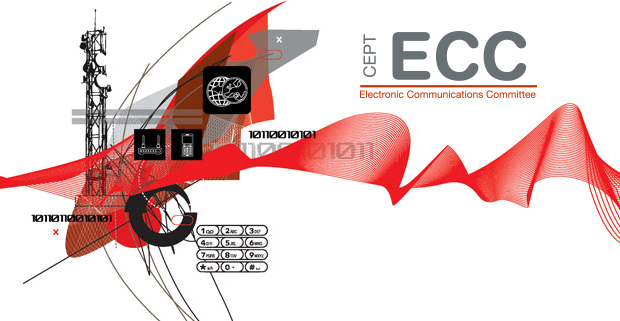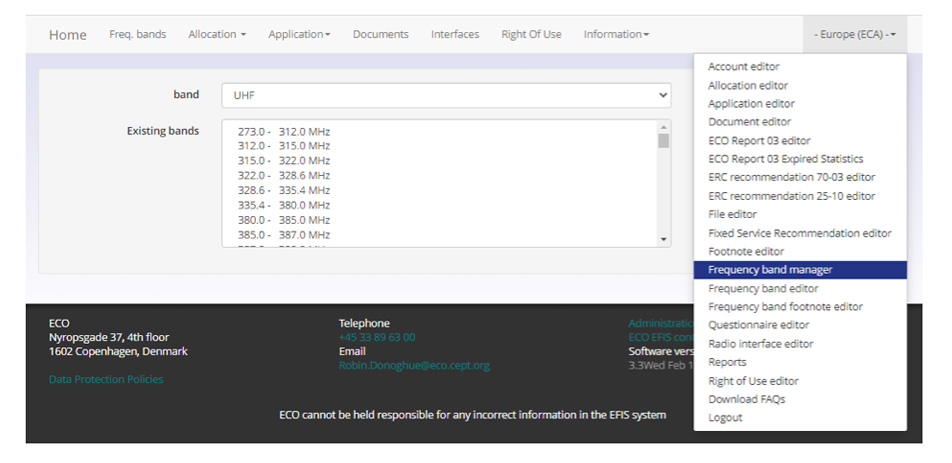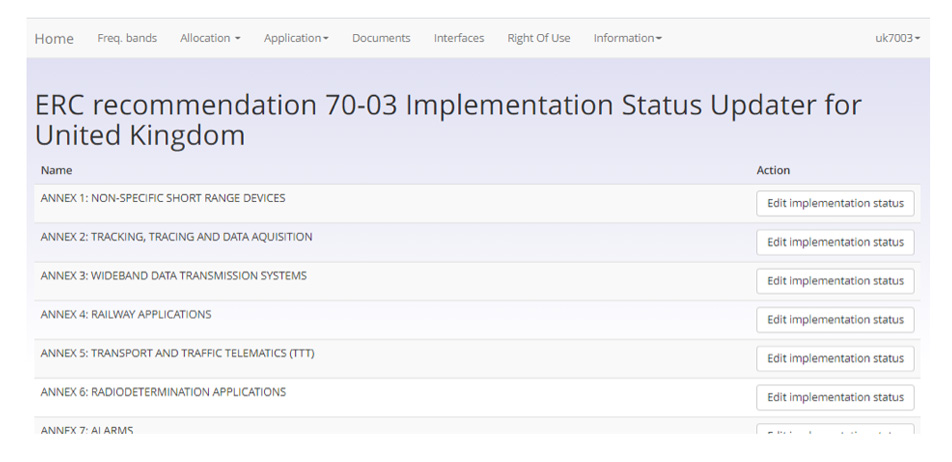ECC Newsletter May 2021
EFIS and the ECA
A guide to EFIS and the European Common Frequency Allocation Table
The ECO had the lengthy task of compiling changes to EFIS in 2020. Here Robin Donoghue, EFIS management expert at the European Communications Office, explains the system’s role in maintaining spectrum information.
Better known as EFIS, the ECO Frequency Information System provides information regarding spectrum use in Europe. This software tool allows public access to search for frequency information of the 48 CEPT Administrations.
Under ECC Decision (01)03, CEPT Administrations are required to enter and maintain spectrum allocations as defined by the ITU-R, the radiocommunication sector. They also must enter and maintain spectrum applications according to the List of Searchable Applications in Annex 2 of the ECC Decision (01)03. CEPT Administrations may also enter information relating to their national radio interfaces and their Rights of Use for tradeable spectrum access.
The ECO maintains the data in EFIS related to the Radio Regulations, in particular the European Table of Frequency Allocations (ECA Table).
Uploading common European frequency information and information specific to CEPT Administrations
The ECO is responsible for maintaining the common European frequency information in EFIS. When logged into the common Europe account, the Office has access to several editor functions.
For example, selected frequency allocations can be edited.
CEPT Administrations are responsible for their own national frequency information and national implementation of ECC harmonisation measures. Within EFIS, the Administrations each have their own national password-protected log-in and access to all the necessary editors within EFIS, to keep their own information maintained.
CEPT Administrations can also ask for the assistance of the ECO in maintaining their national frequency information.
Documents created in EFIS
There are specific documents that are created from the data held in EFIS. This has the advantage that it completely eliminates the chance of conflicting or contradictory information being shown in the system and published documents.
These documents are:
- ECO Report 03 on the licensing of mobile bands in Europe;
- ECO Report 04 on the Fixed Service in Europe;
- ECC Recommendation 25-10 on Frequency Ranges for the Use of Terrestrial Audio and Video Programme Making and Special Events (PMSE) applications;
- ERC Recommendation 70-03 on Short Range Devices in Europe;
- ERC Report 25 the European Common Allocation Table (ECA Table).
Of these, CEPT Administrations have separate passworded national log-ins so that they can update and maintain the national implementation of their fixed service, PMSE and short range devices.
For example, CEPT Administrations can use their log-in to maintain the national implementation of each entry in the ERC Recommendation 70-03 for Short Range Devices.
The ECA Table
The ECA Table ERC Report 025 provides information on the current frequency allocations applicable for CEPT Administrations. The ITU-R Radio Regulations (RR) define Europe as being in Region 1. Hence, the ECA Table is set out in frequency bands as defined by the RR Region 1 allocations.
CEPT first endorsed the principle of adopting a harmonised European table of frequency allocations and applications in 2002. Before then, individual national frequency tables were the only source of allocation information.
The task of developing and maintaining the ECA Table is the responsibility of the Working Group Frequency Management (WG FM) and its EFIS Maintenance Group. However, much of this work is carried out by the ECO on behalf of WG FM.
Regularly updating the ECA Table
Normally, the ECC meets three times a year. Therefore, there may be a need to revise the ECA Table up to three times in one year, depending on whether any new or revised ECC Decisions are approved.
The ECO is permitted to make certain changes to the ECA Table without public consultation, where the change is factual. This includes listing of Harmonised Standards and references to ECC Decisions and ECC Recommendations.
However, where the amended information is of a more substantial nature, including amending the list of RR allocations applicable to Region 1 or Europe, or the amendment of RR Article 5 footnotes applicable to Europe, then a public consultation of the amendment to the ECA Table is required.
The ECA Table is intended to show common frequency allocations and applications – so it sets out the rule for adding them.
A European allocation is considered common and should be listed in the ECA Table where at least 15 CEPT Administrations have recorded in EFIS that the allocation has been made available. For RR Article 5 footnotes, the number of CEPT Administrations is at least 10.
An application can be added to the ECA Table where an ECC or EC harmonisation measure such as ECC Decision, ECC Recommendation or EU Decision harmonises the application. An application can be added when at least 10 CEPT Administrations have made available the relevant frequency band for the radio application according to EFIS. Finally, WG FM may also decide to add an application to the ECA Table.
Updating the ECA Table following the 2019 World Radiocommunication Conference (WRC-19)
The most recent amendment requiring public consultation was made following WRC-19, where several changes were made to the RR.
The changes agreed at WRC-19 represented a significant workload for the ECO. The revisions agreed at the conference included major changes around the following frequency bands;
- 50 MHz-68 MHz;
- 156.8375-161.9375 MHz;
- 1613.8-1626.5 MHz;
- 24.25-25.25 GHz;
- 40.5-42.5 GHz;
- 51.4-52.6 GHz.
There were also many substantive changes to the RR footnotes across the ECA Table, including the addition of 30 new ITU RR footnotes and two new ECA footnotes. These new and revised footnotes needed to be applied across several frequency bands. The revision also introduced a new annex to the ECA Table for receive-only Harmonised Standards. This was done in recognition of changes introduced in several CEPT Administrations following the implementation of the Radio Equipment Directive.
Following WRC-19, the ITU-R published the final acts for the revised RR in March 2020. The EFIS Maintenance Group and the ECO developed a draft revision of the ECA Table, which was approved for public consultation at the 96th WG FM meeting in June 2020. ECC subsequently approved the publication of the revised ECA Table at its meeting 54th ECC in November 2020.
Publication of the ECA Table in the ECC Document Database
Because the ECA Table is created from data held within EFIS, the process for updating the table is similar to that for making any other amendment in EFIS. For any change to a frequency band, the ECO first needs to log in to the editor for the ITU RR Region 1 and make the necessary changes. Only when this is correct can the ECO log in to the Europe editor and change the European Common allocation and footnotes. It is a hierarchical process where the European allocation must be set before any applications, ECC harmonisation measure, Harmonised Standard or comments are added.
On completion of making the editorial amendments in EFIS, the ECA Table can then be made available by the ECO in different formats. In addition to the table being directly accessible within EFIS, the ECO makes it downloadable in CSV format so that it can be easily manipulated or customised in Excel. Finally, the ECO makes the table available in pdf format, which is then made available as a dated document as ERC Report 025 in the ECO Document Database.
Future revision process
The public consultation of the ECA Table has previously been made using a track changed document created by a conversion for the pdf. This had the benefit of showing the ECA table in the same formatting as the published pdf. However, it was cumbersome to edit, and it was not always clear in the marked-up version whether footnotes applied to an allocation or the whole frequency band.
In future revisions the ECO will present a version of the ECA Table for WG FM approved public consultation, which is derived from the CSV /Excel table. As a result, it will be clearer to identify where any change is needed and should significantly streamline the process of editing EFIS.







